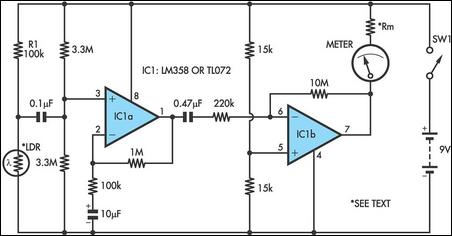Home » Circuits
Heart Rate Monitor
Strictly speaking, this simple circuit shouldn't work! How could anyone expect an ordinary light dependent resistor photo cell to 'see' through a fingertip in natural daylight and detect the change in blood flow as the heart pulsates? The secret is a high gain circuit, based on a dual op amp IC which can be either the low power LM358 or the JFET TL072. The LDR is connected in series across the 9V battery supply via a 100kO resistor (R1) and the minute signal caused by the blood pulsing under the skin is fed to the non-inverting (+) input, pin 3, of IC1a via a 0.µF capacitor.Pin 3 is biased by a high impedance voltage divider consisting of two 3.3MO resistors. The feedback resistors to pin 2 set the gain to 11 times. The output of IC1a is fed via a 0.47µF capacitor and 220kO resistor to IC1b. This is configured as an inverting op amp with a gain of 45 so that the total circuit gain is about 500. The output of IC1b is used to drive an analog meter which may be a multimeter set to the 10V DC range or any panel meter in series with a resistor to limit the current to less than its full-scale deflection. The prototype used an old VU meter with a 47kO resistor fitted in series.
Circuit diagram:
Note that the unit was designed to use the Dick Smith Electronics light dependent resistor (Z-4801). Other LDRs may require a change in the value of resistor R1. A light source such as a high brightness LED is not required. All that is needed is a reasonably well-lit room, preferably natural daylight, to produce a healthy swing of the needle. Only when the hands are very cold does it make it a little more difficult to accurately count the pulses. To check your heart rate, carefully position your thumb or finger over the LDR and count the meter fluctuations for a period of 15 seconds. Then multiply the result by four to obtain your pulse rate. The circuit can not be used if you are walking or running, etc.
Author: Tony Lee
Copyright: Silicon Chip Electronics Magazine
Copyright: Silicon Chip Electronics Magazine

